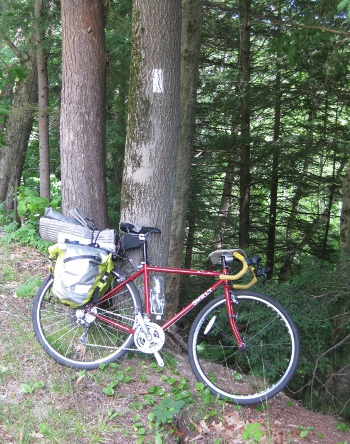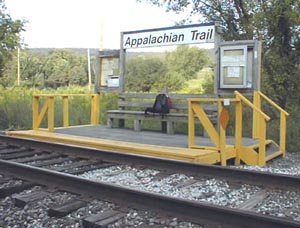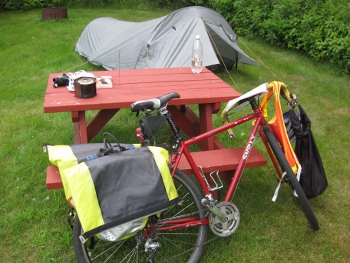
The author's bikepacking setup on the A.T. Read the Trip Report.
Hiking may seem like the “greenest” activity you can do on Earth Day, or any day, with one notable exception: the often considerable drive to the trailhead.
You don't need to be a strident conservationist to appreciate the irony of a tricked-out SUV with a lone occupant, spewing carbon dioxide and volatile organic hydrocarbons on a 200-mile round trip to hike and “appreciate nature.”
A common-sense reply to this criticism is that hikers, despite burning a few gallons of gas here and there, develop a heightened appreciation of nature, and are therefore motivated to conserve land and water quality, maintain trails, and be generally more environmentally-conscious.
Whether or not that holds true, consider that 82 percent of Americans live in urban areas and spend more than 32 hours per year stuck in traffic (according to the 2010 census). Driving in stop-and-go traffic for an hour to arrive at the trail with a bundle of stress isn't exactly a relaxing start to a hike.
Whether you want to reduce the environmental impact of your trip to the trail, avoid road stress on your way out of town, or just don't have a car, consider a few alternate travel techniques to get to the trailhead.
Look Locally
Local food is all the rage, so why not consider local hikes? You'd be surprised by how many great town, county, and state parks are close by. Think of a hike as an afternoon escape, rather than a weeklong trip to a national park.
Resources
To find local parks, try contacting your state's department of natural resources or state park agency. Can't find the website of your local state parks? Try www.stateparks.com.
Gear Tip
Just because it's a day hike doesn't mean you have to leave your backpacking gear at home. I'll often bring a new stove or tarp on a local hike to give it a shakedown test before longer trips.
Carpool
If none of your friends like to hike, consult local hiking and outdoor clubs to see if any offer a ride-board or arrange group hikes.
Resources
Trouble finding a local hiking group? Look at local Sierra Club chapters, American Hiking Society alliance members or try Meetup.
No local groups? Ask at a local outfitter if there are informal local groups. Some larger organizations, like the Appalachian Mountain Club, offer regional shuttle services.
Gear Tip
Be careful to stow your gear carefully and securely to avoid having to poke around in an unfamiliar trunk or play the "whose Swiss Army knife is this?" game. You might even consider adding a luggage tag to your pack to ease identification.
Safety Tip
Just because someone else hikes, doesn't make you exempt from common-sense safety. Don't get into a stranger's car alone, always leave word with a trusted friend or family member about your destination and your expected return, and check the credentials, insurance, and history of hiking clubs and leaders carefully.
Try a Group Hike
Many local hiking clubs organize group hikes. A few, like the Capital Hiking Club in Washington, D.C., will charter a bus to bring the group to a trailhead en masse.
No Groups?
Start your own hiking group. This is a bigger topic than this brief article, but consider using online tools like Trailspace, Facebook,or Meetup to find like-minded people in your area and organize regular hikes.
For an example of a fun, well-organized group hike, see this trip report documenting a recent hike on Tennessee's Fiery Gizzard Trail by a group of Trailspace members. Remember, the safety rules above still apply.
Try Local Mass Transit

Appalachian Trail train station near Pawling, N.Y., on Metro-North's Harlem line. (Copyright © 2010 Michael Brochstein)
Many cities and regions have bus services that pass trailheads. We tend to forget that buses still exist, but I've been pleasantly surprised to find clean, reliable bus services in even the most rural parts of America.
Some national parks, like Acadia, link free local bus services with other regional bus systems, creating opportunities to explore parks car-free.
Beyond buses, many regional rail systems, designed to serve commuters, can take you to trailheads on the outskirts of urban areas. Examples include the SEPTA in Philadelphia, MARC in Maryland, and Metro-North in New York City.
Resources
Trail organizations are beginning to get “on the bus,” with this trend too. Washington Trails Association created a resource specifically for “bus hikes” in Greater Seattle.
The Appalachian Trail Conservancy publishes a Getting to the Trail page and A.T. Shuttle List (PDF) that include info on shuttles and public transport.
Google Maps has integrated information from local transit authorities to provide directions that include bus and train schedules.
Gear Tips
- Bring a travel wallet. Public transit can expose you to an increased risk of theft, so consider keeping your insurance card, credit card, driver's license, and cash in a travel wallet that's easy for you to access, and difficult for pickpockets. Have exact change for buses and trains at the ready to avoid creating a bottleneck.
- Bring hand sanitizer. You should have some for backpacking anyway, but public transit can expose you to more viruses and bacteria.
- Pack smart. Many items, like stove fuel, a knife, bear spray, or even sharp tent stakes, are prohibited or can attract unwelcome attention on public transit. Bury potentially problematic items in your pack.
Try National Mass Transit
Greyhound still offers stops in many small towns near major trailheads. Amtrak also offers stops in surprisingly out-of-the way places and actually crosses the Appalachian Trail in Harpers Ferry, W.V., and near Pawling, N.Y., on Metro-North's Harlem line.
For stations further than a few miles from the trailhead, consider bringing a bike. Most Greyhound buses allow bikes (call the station of departure to confirm) as do many Amtrak trains (Call to confirm. Some require bikes be boxed).
Resources
Gear Tip
Keep your pack close by. This is another reason to pack light. Smaller packs can fit in the overhead compartment or under seats on Amtrak and Greyhound buses. Stowing your pack under the bus slows down your arrival and increases the chance of theft. If you must stow your pack, consider a luggage tag.
Try Bikepacking

The author's bike near Bethel, Maine.
Bikepacking is a hybrid of backpacking and bike touring. For the uninitiated, bike touring might seem like a daunting proposition. Consider, though, that depending on terrain, a 60-mile bike tour is roughly equivalent to a 15-mile hike. In other words, it's no walk in the park, but it's possible for most reasonably fit hikers.
To prepare for bikepacking, think about your gear first. Bike touring trailers that allow you to stow your packed backpack work best for bikepacking, but panniers (saddlebags) work well too. Ultralight hikers could get away with no special equipment and just wearing a pack. Don't forget your helmet, but leave the special bike shoes at home.
After your gear is secure, look for a hiking trail within 20 to 100 miles and plan a safe biking route from your home to the trailhead.
Route-Planning Resources
I use a few primary tools to plan safe bicycle routes:
- Google Map's Bike Routes: A BETA version of a great turn-by-turn route planning tool (watch the Biking Directions on Google Maps video below).
- Adventure Cycling Association: Sells maps of detailed bike tour routes.
- East Coast Greenway: Free online maps and turn-by-turn directions for a bike route from Calais, Maine, to Key West, Florida.
- State Departments of Transportation: Most state DOT's have a state bicycle and pedestrian coordinator. They often have access to free, high-quality bike maps.
Once your gear and route are set, you're set to get on the road. I find that a pre-hike ride puts me on the trail stretched out, de-stressed, and ready to walk.
Gear Tips
- Go light. Think it's important to count ounces backpacking? It's even more so for bikepacking. You'll need to carry additional bike-specific equipment (lock, lube, tools, pump, tubes, etc.), so minimize wherever possible.
- Go dry. If you have to leave your bike somewhere for a few days, in addition to locking and concealing it well, cover it with a tarp. Even a few days of rain can rust your chain and cause problems.
- Avoid clip-ins. Clip-in pedals with special shoes are just another thing to carry. Stick with traditional cages and save weight.
Try Bike Shuttling
For point-point hikes that would ordinarily require two cars or a rented shuttle, try a bike shuttle. Drop a locked and well-concealed bike at the end of your hike, then drive back to the beginning to start hiking.
Gear Tips
- Be prepared. Bring a patch kit, spare tube, multitool, and bike pump and know how to use them. It's no fun blowing a tube in an out-of-the-way place.
- Be safe. Bike shuttles often mean evening rides on country roads. Bring front and rear lights and a reflective vest to avoid problems.
General Gear Tips
With the exception of bikepacking, all of these alternate means of getting to the trail don't require a lot of special gear. Here are a few considerations that might make your trip a little smoother.
- Bring a book. Another nice part of many alternate means of getting to the trailhead is that you can relax and read a bit.
- Bring deodorant. Normally, I wouldn't recommend this, but if you're going to take a crowded bus home from a long hike, your fellow passengers will appreciate it. Most deodorants are available in travel sizes.
- Pack light. Shuttling in and out of buses, trains, and bikes is tough enough. Don't complicate matters with 80 pounds of gear.
- Pack tight. A pack with water bottles, a fly rod, and climbing gear rattling around on the outside is asking for trouble. Additionally, sharp points from trekking poles and crampons can injure co-riders. Get as much equipment as you can inside your pack, and consider a rain cover to keep external gear protected and connected.
These are just a few ideas to get you thinking about alternate ways to get outside. Do you have more ideas? Interesting trips you've taken car-free?
Share your ideas, tips, and questions below.

 by Seth Levy
by Seth Levy









